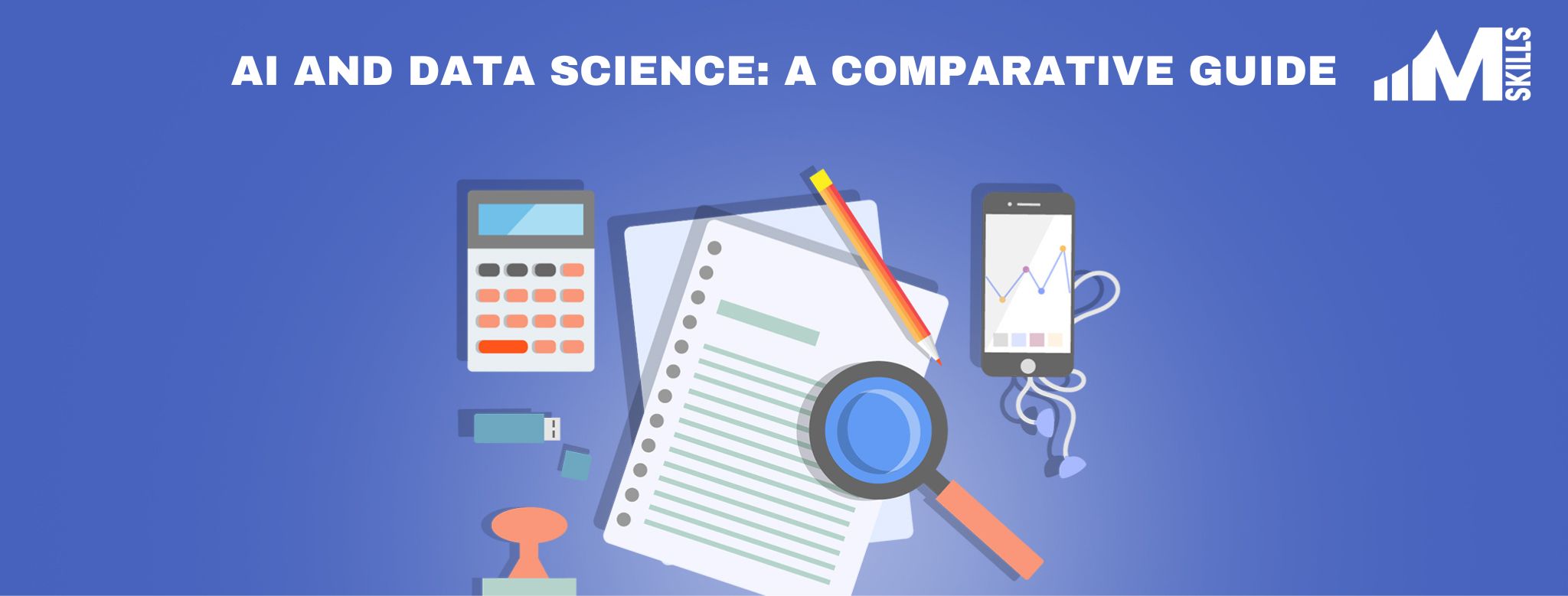AI And Data Science: A Comparative Guide In-Depth
September 21, 2025|
Vanthana Baburao|
Data Science|

Truly said by the CEO of Alphabet, AI has become the most integral part of data science. Data science and AI together are both helping to create a bright future for industries. At present data science courses are also coming up with integrated generative AI modules that will help the aspirants to upskill themselves in the data field.
AI makes work easier, simpler, smoother, and quicker. Industries are deeply concentrating on the usage of AI in more and more work processes. In turn, people are also getting benefitted. For example, maps for direction, voice search, and other such things are all AI-integrated work.
Individuals are getting addicted to such things. Whereas, data science is specifically used by organizations, that helps to analyze data in an efficient way to gain success. Data is a big thing in the present time. Data analysis can reveal the unfolding story.
It helps in understanding patterns and trends and takes the level of the company to another level. It informs about the profit and loss and about various such things that help the organization to grow further. Let us see about both AI and data science.
Fundamentals of Artificial Intelligence
Artificial intelligence or AI is the most important topic of discussion for all genres. People are very curious about the process and deeply interested. As the work of ordinary people is becoming much simpler and easier, people are trying to make AI a part of their lives. Organizations are coming up with new and variant ideas that will link AI with their work process.
AI when juggled with other domains provides excellent reports. For instance, AI and data science, AI with healthcare, similarly in many other sectors. This is making their work quicker and error-free. But are you aware of what this AI is all about?
The history of artificial intelligence goes back many years. There were many small and big inventions happening regarding AI. The inventors were interested in making automated things that could function on their own with specific human intervention.
This concept was paving a roadmap for artificial intelligence. Then between the years 1950 and 1956, artificial intelligence was created. As Alan Turing published his work “Computer Machinery and Intelligence” the term artificial intelligence was coined. It was John McCarthy who first conducted a workshop at Dartmouth on artificial intelligence and from when the term artificial intelligence was used publicly.
Artificial intelligence is the technology that takes the help of machines and computer science to stimulate human intelligence. The technology also helps in problem-solving and making complex work, simpler. Artificial intelligence as the name suggests is the intelligence that is displayed by machines or computers.
Since the intelligence is shown artificially by the machines it is termed artificial intelligence. Artificial intelligence conducts the majority of human work that requires human intelligence. Some of the common examples of AI are GPS, ChatGPT, digital assistant autonomous vehicles, and other tools like this.
Artificial intelligence can self-task or it is combined with other processes in the domain to perform important and necessary tasks. For example, AI is used in healthcare, AI and data science and sensors are all part of AI activities.
AI and data science have combined and aided the company in achieving good results. They are helping the companies to stay ahead of the competition. It is making the process a lot more accurate.
AI helps in working with large volumes of data. This is helping the company to work on a large scale. These features are helping companies raise the level and thus increase the demand for AI and data science.
Artificial intelligence is mentioned with two important learnings. They are machine learning and deep learning. These languages support the making of AI algorithms. It is modeled after the decision-making processes of the human brain, which can be imbibed from accessible data. It helps in making more accurate classifications and predictions over time.
Both machine learning and deep learning are sub-disciplines of artificial intelligence. Both of them use neural networks to learn from large sets of data. These networks are programmatic structures that are patterned after the decision-making processes similar to the human brain.
They consist of layers of interconnected nodes. These nodes help in extracting the features from the data and make interpretations about what the data is representing. We can discuss it in the coming paragraphs.
After knowing what artificial intelligence is and discussing some of its instances, we can now move to other topics that will help us understand AI better. We discuss next about the types of AI.
Also Read:
- Are Data Science Jobs Safe From AI
- Can Data Scientists Work As Data Analyst
- Can Data Scientist Work From Home
- Can Data Scientists Do Freelance
- Data Science and Machine Learning
Types of Artificial Intelligence
After we have elaborately known about AI and also about its history, we study a bit about the classifications of artificial intelligence. Artificial intelligence can be bifurcated in many ways. But here we have mentioned the classification based on the capability of work that is done by artificial intelligence. They are:
- Weak AI
Weak AI, also known as Narrow AI or Artificial Narrow Intelligence (ANI) is a type of artificial intelligence that performs a narrow task or specific task. It consists of most of the commercial work we perform. It is a very common type of AI that is used by individuals regularly. For example: Apple’s Siri search, Amazon’s Alexa search, self-driving cars, various types of games like chess, and many others. It helps in using robust applications. Individuals can use these applications for better understanding and usage.
- Strong AI
Strong AI is composed of both Artificial General Intelligence (AGI) and Artificial Superintelligence (ASI). As the name suggests it has stronger powers than the Narrow AI. Its application is usually used in organizations. Strong AI has a human-like intelligence power that can solve any type of problem. It can think, learn, understand, and do jobs like a human being.
It has human-like capability and power to do any task. ASI is still in the developmental stage. AGI is used in many processes like AI framework and similarly for other things.
These are two types of artificial intelligence based on its working power. These two types of artificial intelligence are in use by both individuals by both individuals and organizations. Still, inventions are going on regarding how to increase the use of artificial intelligence in everyday life for better and more accurate work.
Now we can discuss the sub-disciplines of artificial intelligence. These will include a better value of understanding in the AI domain. It is based on technical aspects.
It concentrates on creating software that can be independently learned by accessing and utilizing data. It uses a neural network. It requires human intervention.
- Deep Learning:
It uses deeper neural networks. It automates the extraction of features from large, unlabelled and unstructured data sets that require no human interventions.
- Natural Language Processing:
It helps the computer machines to understand and interpret the human language. It is majorly used in chatbots, translation activities, and others as such.
- Robotics:
It is the most interesting and most sought-after aspect of artificial intelligence. It aids in designing work, constructing the job, operating it, and using robots and computer systems. These are used for controlling it, getting sensory feedback for information processing, and a lot more services.
These are major sub-disciplines of artificial intelligence. With these types of artificial intelligence, organizations are doing all the necessary work in less amount of time in an efficient way. This in turn guides their customers to use AI and makes their job much easier.
Is AI a boon or Curse?
Artificial intelligence has become a part of individual life. Many important aspects are done with the help of AI that a person can think of. With the rise of internet voice searches, checking GPS, talking with chatbots, and playing games artificial intelligence has gained deep control of our lives. It makes the work accurate, easy, errorless, and fast.
It also involves less labor. The work done with the help of AI is more efficient. As AI is a machine and does not take breaks, a large amount of work is completed in less time. It requires less human intervention. But it has another side too. Artificial intelligence is expensive. Too much of dependency on artificial intelligence makes the individuals a bit lazy.
Artificial intelligence does not involve any type of creative work. The artificial intelligence machine cannot think out of the box, that can only be done by human beings. It has a limited level of understanding. It can do the functions whose information is programmed in it. It may have a chance of raising privacy issues and can also be a concern for privacy and safety.
It requires vigorous monitoring. The last aspect is a concern of all, is that it might bring with itself a minor risk of unemployment for many sectors. Though it is a debatable concern and the chances are less, it can be a concern that is counted as a curse for artificial intelligence.
These are the major knowledge of artificial intelligence. We have read about what is artificial intelligence, how it works, its classifications, and sub-disciplines. We have also studied its merits and demerits. So, from here, we can understand that AI is a helpful technology for the upscaling of organizations.
When AI is combined with other sectors it also creates magic and helps the development of the sector. Here we have also seen briefly how AI and data science are integrated in helping to make the process faster and more reliable for work. Similarly, it is helping the other processes too which is benefitting the whole world.
Now let us know about data science briefly, the fundamentals of data science, and other details of data science that are required to know for any aspirant or professional.
Introduction to Data Science
Data has become the most important element in today’s hi-tech world. The companies are deaf and dumb without data. In this digital era data is the only one that can provide us with the untold story. Data science has become an important subject of study.
Previously, data was not able to impress the masses. But as the world is turning to digital space, data has become the glowing light that is showing companies its path towards success. AI and data science are the modern couples that are enhancing the flavors of the data world. Let us take a glance at data science and what it is concerned with.
Getting data in this digital world is an easy step for organizations. Talent is required for the analysis of the data. Individuals should possess good and sound knowledge to perform all the analytical reports of data.
Data science is a process that involves mathematical and statistical calculations, artificial intelligence, and programming that helps in interpreting data and getting meaningful insight from it. This information is necessary for the organization’s growth and success. It helps in making decisions. The data science process helps in making the following types of analysis:
- Descriptive Analysis
- Diagnostic analysis
- Predictive analysis
- Prescriptive analysis
Data science helps in the process of analyzing data which helps in proper decision-making. This analysis of data helps data scientists to know what happened, why it happened, what will happen, and how to utilize the result of the analysis.
The data science does not only help in technical aspects but it also helps in management aspects. When AI and Data Science are amalgamated, the latest concoction brings joy to organizations.
It helps to do the job indisputably by offering big support to the organizations. Data science involves a few steps that are also referred to as the lifecycle of data science. Those are mentioned below.
The Lifecycle of Data Science:
- Data ingestion:
This stage is about data collection. To proceed with any analysis the data should be gathered. In this step, both structured and unstructured data are gathered from various sources. Like the internet, customers report, log files, pictures, and many other sources.
- Data storage and processing:
As the data is collected from various sources, the data should be separated, cleaned, and kept in specific locations where it will be easy to access. Data storage and structure help to facilitate workflows around analytics, machine learning, and deep learning models. This aspect does not only involve data cleaning but also involves deduplicating, transforming, and combining the data. The combination of data is done using ETL (extract, transform, load).
- Data analysis:
This is the most crucial step. The analysis of data is the crux of the whole data science process. The gathered or collected data needs to be analyzed by the data scientists. They are the one who analyses the data using various tools and techniques and then gathers the information that is hidden in the sets of data. The data scientists become the tongue of the data.
They help in interpreting the meaning of the data and then convert it into the required information. In this step both AI and data science help in getting the work done effortlessly and without any error.
- Communicate:
This is the last step of the data lifecycle. In this step, the data scientists prepare a report for the analyzed data. This step includes the process of data visualization and data presentation. The result is made by using various charts, graphs, and other pictorial representations.
Here tools like Power BI, Tableau, and other such tools are used to prepare the report in a better way. The report needs to be properly communicated to the team because based on this report further actions are taken and decisions are made.
This was the lifecycle of data science. In the data science lifecycle, both AI and data science play an important role. With the help of both these technologies, the companies are getting a great benefit in optimization of the work process, knowing how to get profits, knowing customer trends, and also knowing what action to take for the development and growth of the company.
This was just an introduction to data science that was essential to know for the aspirants who are trying to build a career in data science. The next paragraph discusses the benefits of data science for enterprises.
Why Data Science is Preferred?
Data science is the most important sector in any industry. Most industries are benefiting from the data science domain. This is the most sought-after sector in the industry. As data science is providing companies with all the required facts and figures to grow and develop it is gaining its name in the industrial sector. Below are some of the important aspects that help in knowing why the domain is so much preferred.
- AI and data science help in making improved decision-making.
- Data science helps in building a unique customer science experience.
- It increases efficiency and effectiveness.
- As the companies get the chance to develop and grow it increases the revenue generation
- It helps the organizations to transform potentially as they discover new and transformative patterns.
- As data science helps in making better decisions, in turn, it helps the companies to make new products and solutions.
- It helps in process optimization in organizations.
- Data science aids companies in predicting changes and reacting preferably to different situations.
- The data science process also helps in measuring performance.
- It opens a wide range of job scopes for the aspirants of data science.
These are some of the aspects which are considered as the advantages of the data science. These advantages are making the data science domain turn the head of the industries towards them.
Data science is not only helping industries and helping them in their growth. It is also helping individuals to make a good career in the domain. As it is the most important sector, individuals are keen to join the sector. They are interested in building a career in the domain.
The data science field offers a large number of jobs to its aspirants. There are plenty of jobs available in this domain with a relatively high salary package. The growth and scope of this sector is also high and is expected to grow more.
Individuals pursuing careers in this domain can also start their startups or freelance careers. So, these are the following ways in which data science helps in improving the career as well as supporting organizations to triumph.
FAQs
1. Does data science provide a good career scope?
Data science has a good scope in the future.
2. Does data science with a generative AI module provide a good job scope?
Yes, a career in data science with a generative AI module is useful for getting good jobs.
3. What are the real-life applications of AI?
Virtual assistance, robotics surgery, automated cars, games, GPS, and others.
4. Will AI replace human intelligence?
AI assists humans in building new things but cannot replace it and its creativity.
Conclusion
AI and data science are the two important elements in the technical world. Both of them are very vital for the existence of the company. Both help companies to grow, develop, and achieve great heights of success. When AI is integrated with data science it helps organisations to do the work efficiently and effectively. The organizations can derive a better result by using both of them together. As AI helps organizations to upgrade their standards, data science also helps organizations to set new patterns and trends that help the companies to provide a cutting edge.

Vanthana Baburao
Currently serving as Vice President of the Data Analytics Department at IIM SKILLS......

